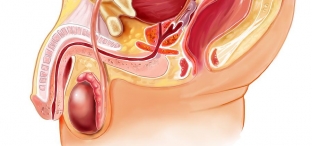In the modern world, the issues of sexology and sexopathology are very relevant and often raised even outside the medical environment. Improving the quality and duration of sexual intercourse is becoming the goal of many clinics and pharmacological companies. New ways to prolong sexual intercourse are constantly being invented, and modern society forces men to ask themselves this problem. But few people think that the line between the norm and pathology is very thin. What if a long erection can turn from a subject of male pride into a dangerous pathological condition? Priapism is a prolonged pathological erection of the penis, which, in the absence of immediate medical attention, can lead to dire consequences, up to the loss of the penis. How can this happen? Read on.
The essence of the concept and the main causes of priapism
Priapism is a prolonged, up to several months, painful erection of the penis, which is not associated with the onset of sexual arousal and does not disappear after sexual intercourse. Pathology is quite rare, and can be both an independent disease and a symptom of another pathology. It is important to remember that prolonged illiterate use of additional methods of stimulating erection can lead to priapism. This condition often occurs after sexual intercourse, the act of urination or defecation without any obvious reason. There are several main factors in the etiology of priapism:
- damage to the central nervous system: brain tumors and injuries, multiple sclerosis or myelitis;
- local pathological processes: tumors or injuries of the penis;
- general pathological processes: infectious diseases, uremia and so on.
Clinical presentation of priapism: main symptoms
The clinical picture of priapism is quite specific: against the background of complete calm, after sexual intercourse, urination or defecation, a spontaneous prolonged erection occurs, which does not disappear after sexual intercourse. A characteristic sign of priapism is the complete absence of ejaculation after sexual intercourse. An erection is accompanied by the presence of pain of varying intensity in the penis and pelvis. At the same time, the appearance of the penis is also quite characteristic: it is arched and tense, the head of the penis is turned towards the abdomen, the skin of the penis becomes bluish in color. There is no blood supply to the cavernous bodies and the glans penis, urination in a patient with priapism is difficult.
The diagnostic process of priapism is not particularly difficult and is based primarily on the data of anamnesis and objective examination. The spontaneous occurrence of penile erection, the inability to ejaculate, the presence of a history of tumors and injuries of the brain and penis, as well as data on past infectious diseases, will suggest the pathological nature of erection. The characteristic appearance of the penis confirms the diagnosis of priapism. In particularly difficult cases, cavernosography is recommended - an x-ray contrast study of the penis. The absence of contrasting of venous vessels on the cavernogram after the injection of a radiopaque substance into the cavernous bodies indicates the absence of venous outflow and confirms the diagnosis of priapism.
Conservative and surgical treatment of priapism
Priapism is an acute condition and requires immediate hospitalization of the patient. Treatment begins with the application of cold compresses to the penis and the administration of sedatives. With a pronounced pain syndrome, antispasmodics and painkillers are administered both intravenously and subcutaneously. Mandatory is the introduction of anticoagulants, as a violation of the venous outflow from the veins of the penis can provoke irreversible life-threatening changes in the tissues of the penis. If conservative methods of treatment are ineffective, surgical intervention is performed: the protein shell of the penis is dissected at its base, blood clots are removed, and an anastomosis is created between the great saphenous vein of the thigh and the cavernous body. Less commonly used is the creation of an anastomosis with a spongy body of the urethra.
Dangerous Consequences of Priapism: How to Avoid Them
Priapism, unfortunately, can lead to serious consequences. Half of the men who have had this disease lose the ability to perform a sexual act and become impotent. Chronization of the process is characterized by the occurrence of frequent causeless erections, which weaken over time, and erectile dysfunction also occurs. In particularly dangerous acute cases, gangrene of the penis may develop: a condition in which amputation of the penis is necessary. Prevention of trauma to the genitals and brain, as well as the proper use of drugs that stimulate erection, will help to avoid priapism and maintain men's health for many years.







Add a comment